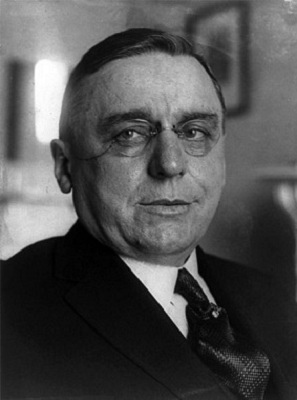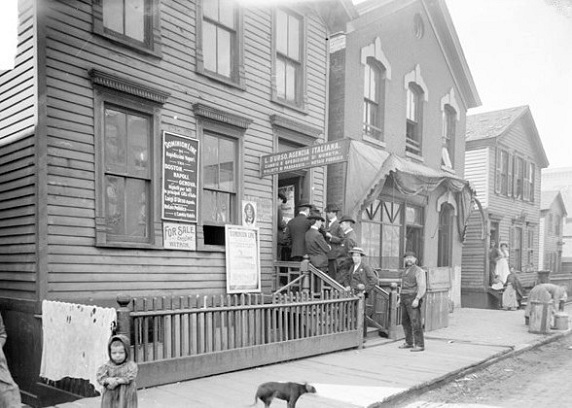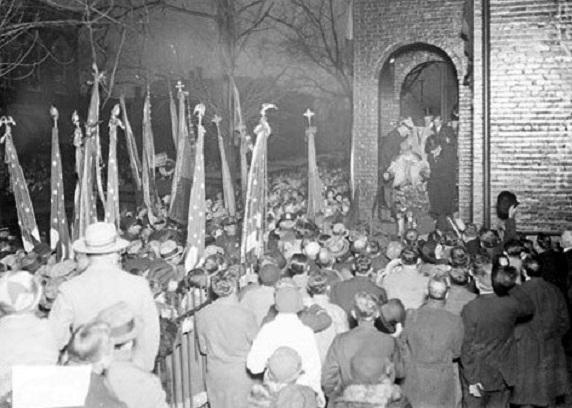How the NATO peoples helped settle Chicago, Part 1
By John R. Schmidt

How the NATO peoples helped settle Chicago, Part 1
By John R. SchmidtHow about something on the impending NATO summit that’s free of controversy? For the next three days, I’ll be doing capsule summaries of how the peoples from the 28 countries each did their part to build Chicago.
Bulgaria—The first Bulgarians settled in Chicago during the first years of the 20th Century. Their numbers were not great, though distinct enclaves developed in Lincoln Square and Albany Park. Immigration has increased in the last 20 years and some sources claim that over 100,000 Bulgarians currently live in metro Chicago.

Canada—In 1880, Canadians were Chicago’s third-largest immigrant group, after the Germans and the Irish. Most of them were English-speaking and could easily assimilate into the local culture. Today there are probably a lot of Chicagoans with a Canadian background, but you’d never know it—unless you ask one of them to say “about.”

Czech Republic—Czechs were commonly referred to as Bohemians in the earliest census reports. Their homeland was then ruled by foreign powers. In the 1870s, large numbers of Czechs began coming to Chicago.
Most of the immigrants settled on the Lower West Side, along the axis of 18th Street. The neighborhood became known as Pilsen, after a city in Bohemia. The more prosperous Czechs later moved west into South Lawndale and suburban Cicero and Berwyn.
Anton Cermak was the Czech prototype of the poor immigrant who made good. He entered politics, got rich, became Mayor of Chicago, and had a major street named after him. Though almost all Chicagoland’s 500,000 Czechs now live in the suburbs, the old 18th Street area is still known as Pilsen.
Estonia—Because their homeland was ruled by their bigger neighbors, early Estonian immigrants were classified as Russian or German. Independence came in 1991 with the collapse of the Soviet Union. Estonian House, in Lake County, serves as a cultural center for Chicago’s Estonian-Americans.
France—The first European to reside in Chicago, Fr. Jacques Marquette, was French. Chicago’s founder, Jean Baptiste Pointe Du Sable, was half-French. And yet, the city has never had a significant French colony. Why not? There’s a likely subject for a doctoral dissertation here.
Italy—A few Italians began coming to Chicago as early as the 1850s. The great wave of immigration began in the 1880s. Over the next four decades the Italians established a significant presence in the city.
The main Italian community was on the Near West Side, along the Taylor Street corridor. Smaller settlements developed on the Near North Side, in North Austin, and in Pullman. During this era Mother Frances Xavier Cabrini helped establish a school, two hospitals, and other social agencies among her people.
The second half of the 20th Century saw many Italians leaving the city and moving into suburbs such as Elmwood Park and Oakbrook. In 2012 about 500,000 people in metro Chicago claim Italian ancestry. The historic focus of the community remains Taylor Street’s Little Italy, now home to the National Italian American Sports Hall of Fame. And don’t forget the Columbus Day Parade!

Latvia—Latvia is a small country, and Chicago never had a large number of Latvians. The 1990 census counted about 7,000 in the metro area. Independence came the next year, and many Latvians have returned to their homeland.
Netherlands—The most obvious reminder of Dutch settlement in metro Chicago is suburban South Holland, founded by immigrant farmers from the Netherlands in 1846. The more urban Dutch people later established an enclave just to the north, in the Roseland neighborhood. The Dutch community is now largely assimilated and dispersed.

Romania—The earliest of the city’s Romanian settlements were on the North Side, in Lakeview and in Edgewater. As with other immigrant groups, many activities revolved around the ethnic parish. Immigration to America has increased in the last two decades, and the Chicago area now has an estimated 100,000 people of Romanian ancestry.
United Kingdom—So who are we talking about here? English? Scots? Welsh? Ulster Irish? None of these peoples lived in distinctive ethnic neighborhoods, but all helped build our city. And I’m writing this—and you’re reading it—in English.


